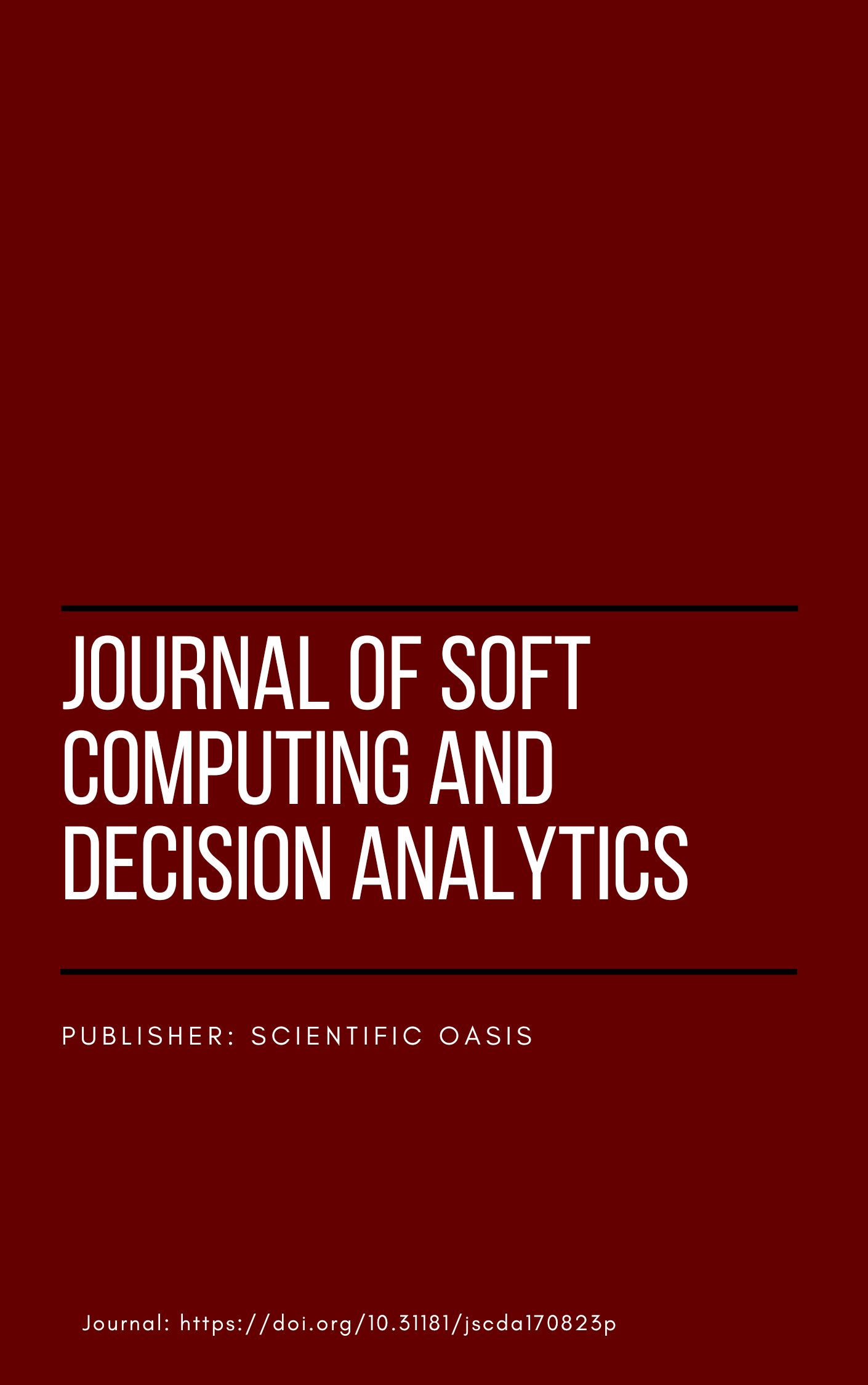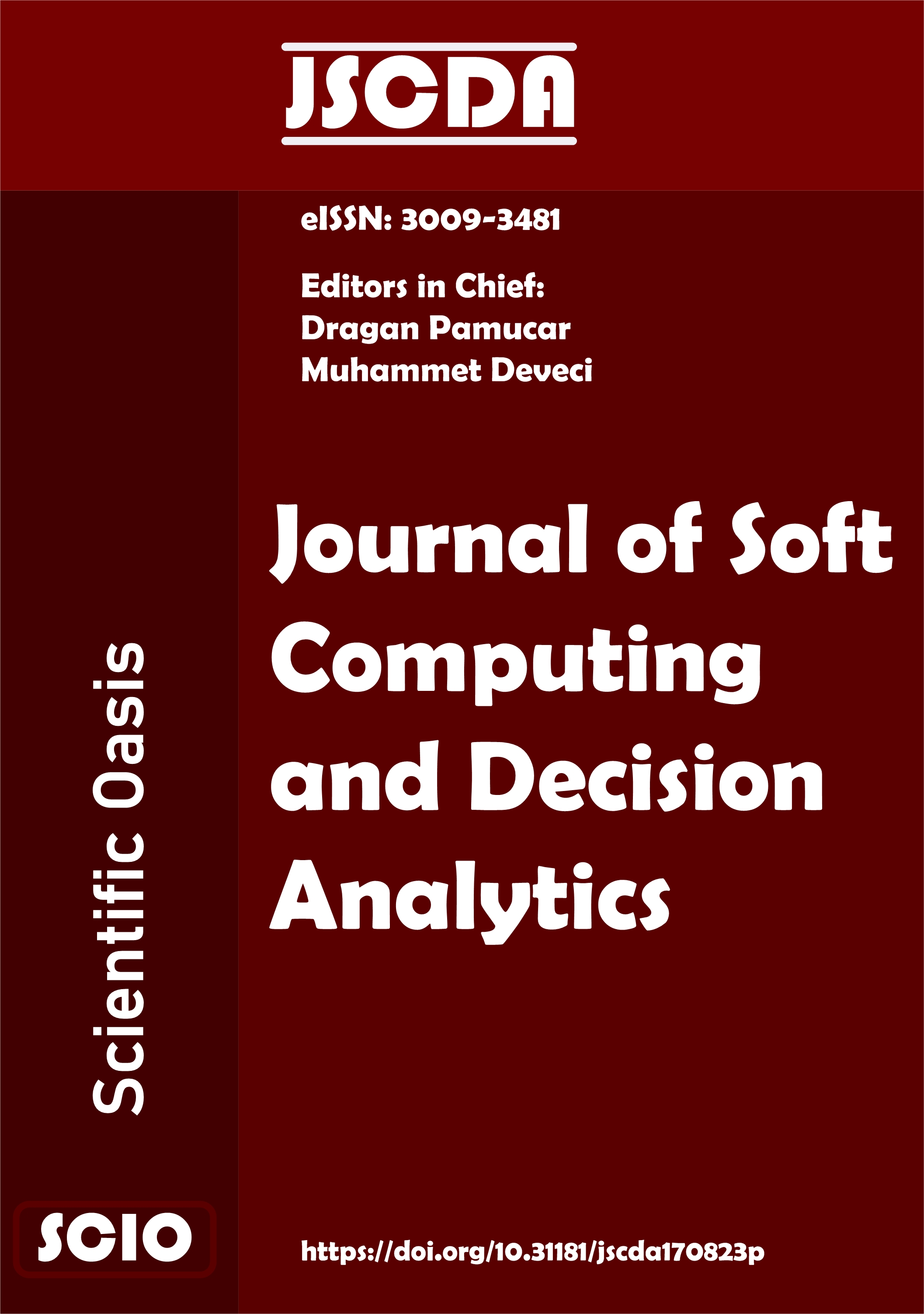Ranking Factors Affecting Sustainable Competitive Advantage From the Business Intelligence Perspective: Using Content Analysis and F-TOPSIS
DOI:
https://doi.org/10.31181/jscda21202430Keywords:
Sustainable Competitive Advantage, Business Intelligence, Brand trust, Social responsibility, Content Analysis, F-TOPSISAbstract
Sustainable competitive advantage, as a key factor in business success, ensures that the company is able to dominate the market with differentiated products and services over a long period of time. This advantage is especially achieved through business intelligence, since smart decisions, leveraging meaningful data and analytics, and continuous process improvement help the company maintain this advantage and experience sustainable growth. The aim of this study is to rank the factors influencing sustainable competitive advantage from a business intelligence standpoint. The research methodology consists of two stages: qualitative and quantitative. In the first step, content analysis was performed to extract indicators from previous studies. In the second step, indicators were ranked using the F-TOPSIS method. Factors affecting sustainable competitive advantage from the business intelligence viewpoint were categorized into 5 criteria, including 27 sub-criteria. The 5 main criteria are customer relationship management, smart marketing, soft and hard organizational factors, and the mental image of the product, respectively. In the second step, the sub-criteria in each criterion were ranked. In customer relationship management, the most important sub-criterion is effective interaction with customers. In smart marketing, the most important sub-criterion is feedback and continuous improvement. Among the soft and hard organizational factors, the most important sub-criteria are support from senior management and technology and infrastructure. In the mental image of the product, the most important sub-criterion is social responsibility.
References
Clauss, T., Kraus, S., Kallinger, F. L., Bican, P. M., Brem, A., & Kailer, N. (2021). Organizational ambidexterity and competitive advantage: The role of strategic agility in the exploration-exploitation paradox. Journal of Innovation & Knowledge, 6(4), 203–213. https://doi.org/10.1016/j.jik.2020.07.003.
Jurksiene, L., & Pundziene, A. (2016). The relationship between dynamic capabilities and firm competitive advantage: The mediating role of organizational ambidexterity. European Business Review, 28(4), 431–448. https://doi.org/10.1108/EBR-09-2015-0088.
Ejrami, M., Salehi, N., & Ahmadian, S. (2016). The effect of marketing capabilities on competitive advantage and performance with moderating role of risk management in importation companies. Procedia Economics and Finance, 36, 22–28. https://doi.org/10.1016/S2212-5671(16)30012-0.
Pangarso, A., Astuti, E. S., Raharjo, K., & Afrianty, T. W. (2020). The impact of absorptive capacity and innovation ambidexterity on sustainable competitive advantage: the case of Indonesian higher education. Entrepreneurship and Sustainability Issues, 7(3), 2436. http://doi.org/10.9770/jesi.2020.7.3(65).
Heidari, A. A., Amiri Sardari, Z., Jamshidi, M. J., & Salarzahi, H. (2020). Investigating the Effects of Infrastructure and Technology of Infrastructure Ecotourism on the Recruitment of Business Angels in Development of Rural Tourism Industry of Kermanshah Province. Journal of Entrepreneurship Development, 13(2), 199–216. https://doi.org/10.22059/jed.2020.300443.653319.
Abdoli Mohamadabadi, T., Ahmadpour Daryani, M., Amiri Sardari, Z., & Karimi, A. (2023). Identifying The Skills Of The Management Team In The Development Of Dynamic Capabilities In New Ventures (Case Study: IT Businesses). Organizational Culture Management. https://doi.org/10.22059/JOMC.2023.360482.1008563 .
Amiri Sardai, Z., Yaghoubi, N. M., & Tabavar, A. A. (2022). The effect of content marketing on Iranian handmade carpets demand’s with using the Data-grounded technique. Consumer Behavior Studies Journal, 9(1), 158–181. https://doi.org/10.34785/J018.2022.417.
Bagheri, R., Zahedian Nezhad, M., Panahi, M. H., & Sadri, M. (2023). Identifying and Evaluating Factors Affecting User Privacy in the Smart City Using the Meta-Synthesis Method and the Fuzzy Dematel Technique. International Journal of Information Technology and Decision Making. https://doi.org/10.1142/S0219622023500530.
Nurcholis, L. (2021). The mediating effect of knowledge exploitability and organizational agility on the relationship between marketing adaptation strategy and sustainable competitive advantage. Contadur’ia y Administración, 66(1). https://doi.org/10.22201/fca.24488410e.2020.2393.
Al-Romeedy, B. S. (2019). Strategic agility as a competitive advantage in airlines–case study: Egypt air. Journal of the Faculty of Tourism and Hotels-University of Sadat City, 3(1), 1–15. https://doi.org/10.21608/mfth.2019.45538.
Azeem, M., Ahmed, M., Haider, S., & Sajjad, M. (2021). Expanding competitive advantage through organizational culture, knowledge sharing and organizational innovation. Technology in Society, 66, 101635. https://doi.org/10.1016/j.techsoc.2021.101635.
Ronaghi, M. H. (2022). Toward a model for assessing smart hospital readiness within the Industry 4.0 paradigm. Journal of Science and Technology Policy Management. https://doi.org/10.1108/JSTPM-09-2021-0130.
Ronaghi, M. H., & Ronaghi, M. (2022). A contextualized study of the usage of the augmented reality technology in the tourism industry. Decision Analytics Journal, 5, 100136. https://doi.org/10.1016/j.dajour.2022.100136.
Ronaghi, M. H. (2021b). Open-source software migration under sanctions conditions. International Journal of System Assurance Engineering and Management, 12(6), 1132–1145.
Ronaghi, M. H. (2021). Evaluating Knowledge Management Maturity by interval type 2 fuzzy sets. Library and Information Sciences, 24(1), 156–173. https://doi.org/10.1007/s13198-021-01329-y.
Ronaghi, M. H. (2022). The effect of virtual reality technology and education on sustainable behavior: A comparative quasi-experimental study. Interactive Technology and Smart Education, ahead-of-print. https://doi.org/10.1108/ITSE-02-2022-0025.
Ronaghi, M. H., Zeinodinzadeh, S., & Alambeladi, S. (2019). Identification and Ranking the Factors Affecting the Knowledge Management Implementation Using Metasynthesis Method. Library and Information Sciences, 22(3), 112–135. https://doi.org/10.30481/ijlis.2019.183033.1553.
Alighaleh, P., Gundoshmian, T. M., Alighaleh, S., & Rohani, A. (2023). Feasibility and reliability of agricultural crop height measurement using the laser sensor array. Information Processing in Agriculture. https://doi.org/10.1016/j.inpa.2023.02.005.
Ed-Dafali, S., Al-Azad, M. S., Mohiuddin, M., & Reza, M. N. H. (2023). Strategic orientations, organizational ambidexterity, and sustainable competitive advantage: Mediating role of industry 4.0 readiness in emerging markets. Journal of Cleaner Production, 401, 136765. https://doi.org/10.1016/j.jclepro.2023.136765.
Alighaleh, P., Pakdel, R., Ghanei Ghooshkhaneh, N., Einafshar, S., Rohani, A., & Saeidirad, M. H. (2023). Detection and Classification of Saffron Adulterants by Vis-Nir Imaging, Chemical Analysis, and Soft Computing. Foods, 12(11), 2192. https://doi.org/10.3390/foods12112192.
Alighaleh, P., Khosravi, H., Rohani, A., Saeidirad, M. H., & Einafshar, S. (2022). The detection of saffron adulterants using a deep neural network approach based on RGB images taken under uncontrolled conditions. Expert Systems with Applications, 198, 116890. https://doi.org/10.1016/j.eswa.2022.116890.
Weihong, X., Caitao, S., & Dan, Y. (2008). A study on the relationships between organizational culture, organizational learning, technological innovation and sustainable competitive advantage. 2008 International Conference on Computer Science and Software Engineering, 5, 9–13. https://doi.org/10.1109/CSSE.2008.92.
Dixit, S., Singh, S., Dhir, S., & Dhir, S. (2021). Antecedents of strategic thinking and its impact on competitive advantage. Journal of Indian Business Research, 13(4), 437–458. https://doi.org/10.1108/JIBR-08-2020-0262.
Teoh, B. A., Teoh, P. C., Tan, H. C., & Ibrahim, A. (2023). What is next for sustainable competitive advantages in pandemic outbreak context?. International Journal of Productivity and Performance Management, 72(4), 986-1000. https://doi.org/10.1108/IJPPM-06-2021-0336.
Malik, M., Ali, M., Latan, H., & Chiappetta Jabbour, C. J. (2023). Green project management practices, green knowledge acquisition and sustainable competitive advantage: Empirical evidence. Journal of Knowledge Management. https://doi.org/10.1108/JKM-06-2022-0466.
Salunke, S., Weerawardena, J., & McColl-Kennedy, J. R. (2019). The central role of knowledge integration capability in service innovation-based competitive strategy. Industrial Marketing Management, 76, 144–156. https://doi.org/10.1016/j.indmarman.2018.07.004.
Zhang, X., Chu, Z., Ren, L., & Xing, J. (2023). Open innovation and sustainable competitive advantage: The role of organizational learning. Technological Forecasting and Social Change, 186, 122114. https://doi.org/10.1016/j.techfore.2022.122114.
Ronaghi, M., & Feyzi, K. (2014). Effective Factors on Education Policies and Academic Technology. Education Strategies in Medical Sciences, 7(3), 167–173. http://edcbmj.ir/article-1-477-en.html.
Ronaghi, M. H. (2022). The influence of artificial intelligence adoption on circular economy practices in manufacturing industries. Environment, Development and Sustainability, 1–26. https://doi.org/10.1007/s10668-022-02670-3.
Yang, J. (2005). Knowledge integration and innovation: Securing new product advantage in high technology industry. The Journal of High Technology Management Research, 16(1), 121–135. https://doi.org/10.1016/j.hitech.2005.06.007.
Jashnabadi, J. N., Pooya, A., & Bagheri, R. (2023). Provide a model for budget policy in university-community communication programs with a system dynamics approach (case study: Ferdowsi University of Mashhad). J. Ind. Manag. Perspect, 13(1), 9–39. https://doi.org/10.48308/jimp.13.1.9.
Rezazadeh, J., Bagheri, R., Karimi, S., Nazarian-Jashnabadi, J., Nezhad, M. Z. (2023). Examining the Impact of Product Innovation and Pricing Capability on the International Performance of Exporting Companies with the Mediating Role of Competitive Advantage for Analysis and decision making. Journal of Operational Intelligence. 1(1), 30-43. http://dx.doi.org/10.31181/jopi1120232.
Guo, R., Cai, L., & Fei, Y. (2019). Knowledge integration methods, product innovation and high-tech new venture performance in China. Technology Analysis & Strategic Management, 31(3), 306–318. https://doi.org/10.1080/09537325.2018.1500688.
Arokodare, M. A., Asikhia, O. U., & Makinde, G. O. (2019). Strategic Agility and Firm Performance: The Moderating Role of Organisational Culture. Business Management Dynamics, 9(3). http://dx.doi.org/10.34257/GJMBRAVOL20IS3PG7.
Muriithi, S. M. (2021). Organisational Culture: The Root of Sustainable Competitive Advantage. http://repository.daystar.ac.ke/xmlui/handle/123456789/3656.
Almuslamani, H. A., & Daud, S. (2018). Organizational culture and sustainable competitive advantage in manufacturing companies in Bahrain. International Journal of Social Sciences, 12(2), 431–441. http://dx.doi.org/10.18576/amis/120218.
Kuncoro, W., & Suriani, W. O. (2018). Achieving sustainable competitive advantage through product innovation and market driving. Asia Pacific Management Review, 23(3), 186–192. https://doi.org/10.1016/j.apmrv.2017.07.006.
Haseli, G., & Sheikh, R. (2022). Base criterion method (BCM). In Multiple Criteria Decision Making: Techniques, Analysis and Applications (pp. 17–38). Springer. https://doi.org/10.1007/978-981-16-7414-3_2.
Haseli, G., & Jafarzadeh Ghoushchi, S. (2022). Extended base-criterion method based on the spherical fuzzy sets to evaluate waste management. Soft Computing, 26(19), 9979–9992. https://doi.org/10.1007/s00500-022-07366-4.
Kuvvetli, Y., Deveci, M., Paksoy, T., & Garg, H. (2021). A predictive analytics model for COVID-19 pandemic using artificial neural networks. Decision Analytics Journal, 1, 100007. https://doi.org/10.1016/j.dajour.2021.100007.
Zafaranlouei, N., Ghoushchi, S. J., & Haseli, G. (2023). Assessment of sustainable waste management alternatives using the extensions of the base criterion method and combined compromise solution based on the fuzzy Z-numbers. Environmental Science and Pollution Research, 30(22), 62121–62136. https://doi.org/10.1007/s11356-023-26380-z.
Haseli, G., Sheikh, R., & Sana, S. S. (2020). Base-criterion on multi-criteria decision-making method and its applications. International Journal of Management Science and Engineering Management, 15(2), 79–88. https://doi.org/10.1080/17509653.2019.1633964.
Ghoushchi, S. J., Osgooei, E., Haseli, G., & Tomaskova, H. (2021). A novel approach to solve fully fuzzy linear programming problems with modified triangular fuzzy numbers. Mathematics, 9(22), 2937. https://doi.org/10.3390/math9222937.
Haseli, G., Torkayesh, A. E., Hajiaghaei-Keshteli, M., & Venghaus, S. (2023). Sustainable resilient recycling partner selection for urban waste management: Consolidating perspectives of decision-makers and experts. Applied Soft Computing, 137, 110120. https://doi.org/10.1016/j.asoc.2023.110120.
Haseli, G., Ranjbarzadeh, R., Hajiaghaei-Keshteli, M., Ghoushchi, S. J., Hasani, A., Deveci, M., & Ding, W. (2023). HECON: Weight assessment of the product loyalty criteria considering the customer decision’s halo effect using the convolutional neural networks. Information Sciences, 623, 184–205. https://doi.org/10.1016/j.ins.2022.12.027.
Bonab, S. R., Haseli, G., Rajabzadeh, H., Ghoushchi, S. J., Hajiaghaei-Keshteli, M., & Tomaskova, H. (2023). Sustainable resilient supplier selection for IoT implementation based on the integrated BWM and TRUST under spherical fuzzy sets. Decision Making: Applications in Management and Engineering, 6(1), 153–185. https://doi.org/10.31181/dmame12012023b.
Nazarian-Jashnabadi, J., Bonab, S. R., Haseli, G., Tomaskova, H., & Hajiaghaei-Keshteli, M. (2023). A dynamic expert system to increase patient satisfaction with an integrated approach of system dynamics, ISM, and ANP methods. Expert Systems with Applications, 234, 121010. https://doi.org/10.1016/j.eswa.2023.121010.
Haseli, G., Bonab, S. R., Hajiaghaei-Keshteli, M., Ghoushchi, S. J., & Deveci, M. (2023). Fuzzy ZE-numbers Framework in Group Decision-making using the BCM and CoCoSo to Address Sustainable Urban Transportation. Information Sciences, 119809. https://doi.org/10.1016/j.ins.2023.119809.
Nezhad, M. Z., Nazarian-Jashnabadi, J., Rezazadeh, J., Mehraeen, M., & Bagheri, R. (2023). Assessing dimensions influencing IoT implementation readiness in industries: A fuzzy DEMATEL and fuzzy AHP analysis. Journal of Soft Computing and Decision Analytics, 1(1), 102–123. https://doi.org/10.31181/jscda11202312.
Haseli, G., Ögel, .Ilkin Yaran, Ecer, F., & Hajiaghaei-Keshteli, M. (2023). Luxury in female technology (FemTech): Selection of smart jewelry for women through BCM-MARCOS group decision-making framework with fuzzy ZE-numbers. Technological Forecasting and Social Change, 196, 122870. https://doi.org/10.1016/j.techfore.2023.122870.
Downloads
Published
Issue
Section
License
Copyright (c) 2023 Scientific Oasis

This work is licensed under a Creative Commons Attribution-NonCommercial-NoDerivatives 4.0 International License.
















